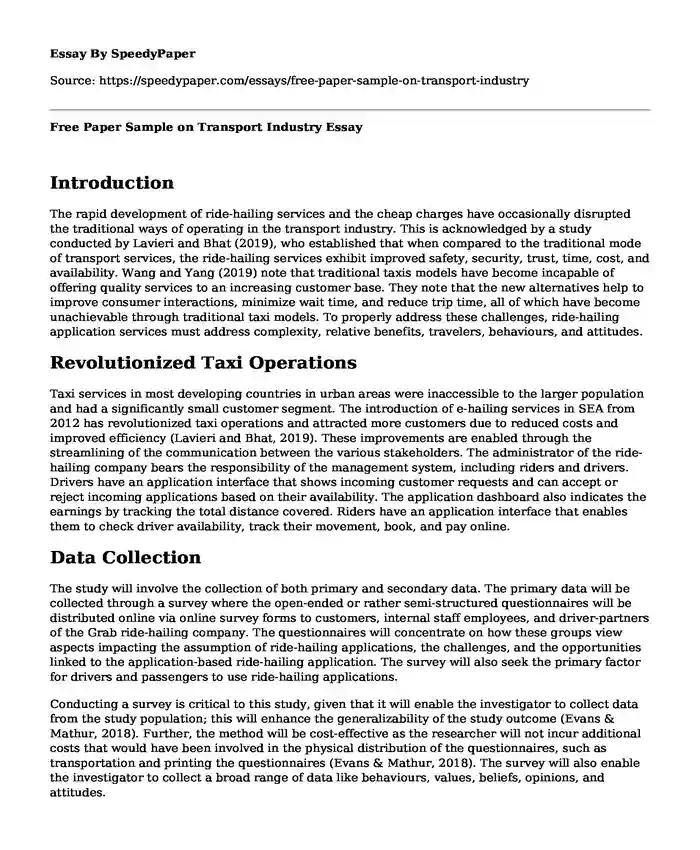
| Type of paper: | Essay |
| Categories: | Data analysis Public administration |
| Pages: | 3 |
| Wordcount: | 734 words |
Introduction
The rapid development of ride-hailing services and the cheap charges have occasionally disrupted the traditional ways of operating in the transport industry. This is acknowledged by a study conducted by Lavieri and Bhat (2019), who established that when compared to the traditional mode of transport services, the ride-hailing services exhibit improved safety, security, trust, time, cost, and availability. Wang and Yang (2019) note that traditional taxis models have become incapable of offering quality services to an increasing customer base. They note that the new alternatives help to improve consumer interactions, minimize wait time, and reduce trip time, all of which have become unachievable through traditional taxi models. To properly address these challenges, ride-hailing application services must address complexity, relative benefits, travelers, behaviours, and attitudes.
Revolutionized Taxi Operations
Taxi services in most developing countries in urban areas were inaccessible to the larger population and had a significantly small customer segment. The introduction of e-hailing services in SEA from 2012 has revolutionized taxi operations and attracted more customers due to reduced costs and improved efficiency (Lavieri and Bhat, 2019). These improvements are enabled through the streamlining of the communication between the various stakeholders. The administrator of the ride-hailing company bears the responsibility of the management system, including riders and drivers. Drivers have an application interface that shows incoming customer requests and can accept or reject incoming applications based on their availability. The application dashboard also indicates the earnings by tracking the total distance covered. Riders have an application interface that enables them to check driver availability, track their movement, book, and pay online.
Data Collection
The study will involve the collection of both primary and secondary data. The primary data will be collected through a survey where the open-ended or rather semi-structured questionnaires will be distributed online via online survey forms to customers, internal staff employees, and driver-partners of the Grab ride-hailing company. The questionnaires will concentrate on how these groups view aspects impacting the assumption of ride-hailing applications, the challenges, and the opportunities linked to the application-based ride-hailing application. The survey will also seek the primary factor for drivers and passengers to use ride-hailing applications.
Conducting a survey is critical to this study, given that it will enable the investigator to collect data from the study population; this will enhance the generalizability of the study outcome (Evans & Mathur, 2018). Further, the method will be cost-effective as the researcher will not incur additional costs that would have been involved in the physical distribution of the questionnaires, such as transportation and printing the questionnaires (Evans & Mathur, 2018). The survey will also enable the investigator to collect a broad range of data like behaviours, values, beliefs, opinions, and attitudes.
Additionally, the researcher will seek the company's internal operational staff's help in distributing the online questionnaire links to the Driver community WhatsApp groups. Further, the link to the questionnaires will be broadcasted to the company's employees known to the researcher. It will also be shared with other employees of the company via email, LinkedIn, and WhatsApp. The researcher will review not less than 12 returned questionnaires from each group (customers, drivers, and staff), with the minimum number of questionnaires analysed being 36. There is limited literature concerning the regulation of ride-hailing services, especially in the context of Indonesia. Secondary data will be systematically collected from the Grab riding-services website and online sources, including photographs, social media posts and web content, newspapers, books, and scholarly journals.
Conclusion
The study will assess particularly how each of these groups considers the social impacts of ride-hailing services applications, what factors determine their preference to use the service, and the challenges or opportunities for the Grab application adoption in Indonesia. Both the primary and secondary data will be analysed thematically. The thematic analysis process will involve six major phases discussed below (Nowell, Norris, White, & Moules, 2017). In the first step (familiarization), the investigator will familiarize themselves with the data by reading through and taking notes of the data collected via questionnaires. In the second stage, the author will segment and categorize the data, after which he will develop patterns. The author will identify relationships, patterns, and themes by interpreting the data information in the third step. In the fourth stage, the investigator will review the themes to ascertain whether they are useful and present the collected data accurately. In the fifth stage, the researcher will name and define the themes.
Cite this page
Free Paper Sample on Transport Industry. (2024, Jan 03). Retrieved from https://speedypaper.net/essays/free-paper-sample-on-transport-industry
Request Removal
If you are the original author of this essay and no longer wish to have it published on the SpeedyPaper website, please click below to request its removal:
- Essay Example on the Synthesis and Use of Epoxy Resin
- Organizational Climate in Healthcare Settings - Statistics Essay Example
- Essay Sample on Freeholders Meeting
- Essay Sample on Research Method and Design
- Paper Exampl on How X-Rays Are Formed Within the X-Ray Tube
- Paper Example on HR Data Elements
- The Contamination of Air by Lead. Free Essay
Popular categories




